-
Paper Information
- Next Paper
- Previous Paper
- Paper Submission
-
Journal Information
- About This Journal
- Editorial Board
- Current Issue
- Archive
- Author Guidelines
- Contact Us
Software Engineering
p-ISSN: 2162-934X e-ISSN: 2162-8408
2012; 2(3): 65-76
doi: 10.5923/j.se.20120203.04
Software of Information-Measurement System for Standardless Diagnostic of Composite Materials
V. S. Eremenko , A. V. Pereidenko
National Aviation University, Information-Measuring Systems Department, Kiev, 03680, Ukraine
Correspondence to: A. V. Pereidenko , National Aviation University, Information-Measuring Systems Department, Kiev, 03680, Ukraine.
| Email: |  |
Copyright © 2012 Scientific & Academic Publishing. All Rights Reserved.
This article is devoted to software realization via NI LabVIEW 2011 for system of the standardless diagnostic of technical objects. The solution requires methods that are fast and efficient in diagnostics, adapted for usage condition changes, oriented for wide set of objects under control and without changes in the main software structure. The structure and main modules of developed software is represented in the article. Developed software advantages are in its architecture flexibility, high performance and reliability of data signal processing, human-engineered interface. The software of standardless diagnostics system is based on neural network classifier which provides flexible and stable knowledge base about possible classes of defects, performs effective operations with high dimensional data vectors, adapts its architecture for solving new tasks and provides the high reliability of control. The classifier based on hybrid neural network, ART-2 and Fuzzy-ART neural networks for classification of defects in honeycomb panels were introduced and investigated. Described classifier during the training can automatically change its settings, reaching the highest reliability of the control, detect and classify subsurface defects in honeycomb panels with high reliability and accuracy, as well as defects that are located on the back side of the cladding with plottage larger than 2 cm2 and thickness of composite panel equal to 12.8 mm. The reliability of the nondestructive testing via specified classifier is more than 95%. Results of the developed special software practical usage for honeycomb panels’ technical state classification were represented
Keywords: Standardless Diagnostic, System of Nondestructive Testing, Neural Network, NI LabVIEW 2011, Honeycomb Panel
Article Outline
1. Introduction
- There are many methods and systems to diagnosis and classify the technical state of objects under control (OUC) [1-4]. However, their usage does not allow perform high quality of standardless diagnostics of products that have complicated structure: composite material products, blades of gas turbine engines, bandage of electric locomotive wheelset, etc. Standardless diagnostics of such objects should be performed with methods which would allow accumulate retrieved information about new defects, expand existed base of defects and increase diagnostics system precision without restarting (but in runtime). The other problem is the high number of informative parameters that describe the technical state of object under control. In such cases the number of dimensions of the features space (that used for decision rules making) is high. It is difficult to use statistical methods for these purposes, because the analysis of high dimensional probability distribution functions should be performed. It results in significant usage of hardware and time resources.Nowadays the developing of standardless diagnostics methods for controlling the technical state of products with complicated structure is actual problem. There are many researches devoted to problems of information-measuring systems construction and such issues as improvement of efficiency, accuracy, noise immunity, reliability,performance, and software polymorphism of these systems[5-8]. The solution requires methods that are fast and efficient in OUC diagnostics, adapted for usage condition changes, oriented for wide set of OUC and without changes in the main software structure[5].Software of such diagnostics system must include next two blocks:• Diagnostics block. Its function is to find the parts with defects (anomalies) and/or to form studying samples for classification problems. Tasks of this block could be divided on three groups:a. indicating diagnostics characteristics for different OUCs states (valid or invalid);b. forming learning samples for every object state;c. decision rule making based on input vector of diagnostics characteristics analysis.• Classification block. There are three groups of its functions:a. indicating diagnostics characteristics for different OUCs states (damage levels, defect types, etc.);b. forming features space and separating hyperplanes;c. classifying input informative signals using different classification methods.Among the most popular methods of standardlessdiagnostics and classification (based on separating hyperplanes [9-12], statistical analysis of the spectral densities[13-16] or analysis via artificial neural networks[17-21]) there are methods based on artificial neural networks (NN). Usage of such methods has next advantages: high noise immunity, high diagnostics efficient[19-23], etc. It allows increase the control reliability and performance, reduce systemrealization cost and hardware resources. Neural networks give opportunity to perform clustering analysis[24,25], build complicated separating hyperplanes and performclassification of objects under control[26]. They learn new information and expand existing knowledge base about nomenclature of possible classes without information loss.There is a lot of publications[19-23] in which the questions of efficient NN applying for tasks of objects under control state and defects determining, signal registration and classification, cluster analysis, etc. are discussed. For selection an optimal structure of NN that will be used as a part of informational-measuring system for nondestructive testing, it was investigated a set of such popular neural network architectures as Kohonen NN[25], multilayer perceptron[26], special hybrid NN[9,10], NN of adaptive resonance theory (ART nets), ART-2 net[17,27,28] and Fuzzy-ART[18,29]. As the result of analysis of these architectures the decision to use as the classifier core the ART-2, Fuzzy-ART and the hybrid neural network (which based on Kohonen NN and multilayer perceptron) was made. All these neural networks allow retrieve the highest control reliability during diagnostics of products from composite materials[17,18].
2. Problem Solving
- For solving described problems authors have developed special information-measurement system (software and some modules of hardware) for standardless diagnostics of composite materials. The software of standardlessdiagnostics system is based on neural network classifier which provides flexible and stable knowledge base about possible classes of defects, performs effective operations with high dimensional data vectors, adapts its architecture for solving new tasks and provides the high reliability of control. Neural networks also provide the invariance of system usage, efficient input data processing, analysis and classification without dependence on diagnostics and data collecting methods.There are different software packages such as MathLab [30], NeuroSolution[31], NeuroPro[32], STATISTICA[33] and others that provide the ability to work with mathematical apparatus of neural networks. These packages could be used for solving the wide verity of problems. But in other hand they restrict the available NN architecture usage and do not allow performing adjustment on neuron level, creating add-ons and developing new learning and functional algorithms of NN. Some architectures of neural networks are absent in such software packages. Based on this fact software development of the nondestructive testing system was performed by authors in NI LabVIEW 2011 development environment. This environment provides graphical programming language G and does not restrict the NN model implementation. NI LabVIEW[34,35] allows developing new learning and functional NN algorithms, creating new types of NN or merging/joining existing nets in one functional system. Also it is possible to use existing programming modules and DLLs. LabVIEW 2011 environment performs parallel execution of algorithms which increases the performance of created nondestructive testing system software.The nondestructive testing system software is developed by authors like a set of independent modules because of the need to solve the problem of standardless diagnostics for different object under control types with usage of only one system with possible minor changes for each specific task (difference could be in changing few existing functions or including new one for specific diagnostics tasks). It allows connecting and integrating created earlier libraries and modules (which were developed with high level languages) in the system core without its significant changes. This approach permits adding new or excluding unnecessary functionality, performing fast reconfiguration,modernization, adaptation, etc. without any complexity.Developed system for OUC technical state diagnostics is oriented on work with standard devices for retrieving initial information (defectoscopes) as well as with specialized data retrieving devices (for specific tasks and OUC) which based on analog-digital converters (ADC).This is achieved by using generalized input-output module (I/O Module) which is developed by authors and interacts with defectoscopes or with specialized data retrieving systems. In the developed standardless diagnostics system structure (Fig. 2) there are two main parts: hardware (includes a set of sensors, data acquisition unit and I/O Module) and software.
3. Hardware Part
- The system’s hardware part consists next blocks:• Set of sensors – initial physical parameter transformers into electric signal;• Data acquisition unit – data acquisition platform cDAQ or cRIO (National Instruments) with set of ADC and specialized modules or specialized defectoscope that is used for experimental data acquisition;• I/O Module – interacts with defectoscopes or with specialized data retrieving systems and transmits data for subsequent data processing.In case of use cDAQ platform (Fig. 1) communication with PC is performed via USB 2.0 interface. Channel capacity is equal to 3.2Mb/s. A set of ADC modules varies depending on specific tasks (required number of channels, sampling rate, dynamic range of input signal, etc). In the developed system the ADC NI 9215 is used. It has 4 simultaneously sampled analog inputs, 100 kS/s, ± 10V dynamic range, 16-bit resolution and 40 to 70 °C operating range.
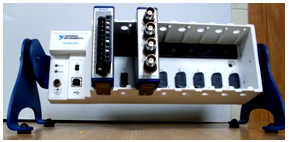 | Figure 1. cDAQ data acquisition platform |
4. Software Part
- Interaction between I/O Module and PC, information stream organization, data processing algorithms realization and displaying the result was implemented by authors in software part of the system (mathematical support, dataware and I/O Module software). The software architecture is displayed on Fig.3.There are next main modules of system software:• ADC control module. This module includes units for configuring ADC parameters (sampling rate, dynamic range of input signals, number of ADC channels, synchronization source, etc.).• System’s regime control module. It is used for configuring such parameters of the system regime like the input data source (defectoscope, ADC or physical/optical data storage), system regime, etc.• Data storages interaction control module. It allows reading/writing data from/to data storage. It also forms array or subarray of necessary informative parameters for importing them to other diagnostics systems or for creating reports. In case when reading operation is performed this module forms the array from the stored data and represents it in required format.• Reporting facilities and system output control modules. These modules perform data transformation to convenient user-friendly format in case of data displaying or to required data storage format in case of data saving. Also it is possible to display or save on storage parameters of neural networks which are used in the system.• Control module for system database. It allows read/write set of formed classes during system work as well as their additional specific parameters.• Control module for neural networks. It allows user to choose the type of neural network that will be used for data processing and classification and setup its parameters. This module contains units which perform class forming of OUC, finding new classes, anomalies, and converting the neural network output to user-friendly format.• Data buffer control module. This module writes retrieved data from ADC or defectoscope to array which further could be processed or saved for processing in future by current or another diagnostics system.• Data processing module. It allows choosing the necessary diagnostics characteristics which the most informative for current case and use them instead the full set of characteristics. In some cases the data vectors of small dimension size could be used. For efficient diagnostics system work the input data should be preprocessed to in specific way. That’s why in this module the necessary algorithms are executed.Fig. 4 illustrates the interface of developed system. It contains control elements for ADC setting up, preparing and normalizing input data, choosing neural network type, choosing the NN learning algorithm and other parameters of NN. System user interface also contains elements for saving detected data signals, loading data form physical or optical storages, saving system output reports, etc.The system allows:• input signal visualization;• detecting input signals informative parameters;• performing input signal preprocessing;• performing input data cluster analysis;• determining and building separating hyperplanes;• classifying the state of OUC and displaying the characteristics of its class;• saving the values of selected informative parameters;creating decision rule;• converting obtained results to user-friendly format.
 | Figure 2. Standardless diagnostics system structure |
 | Figure 3. Nondestructive testing system software architecture |
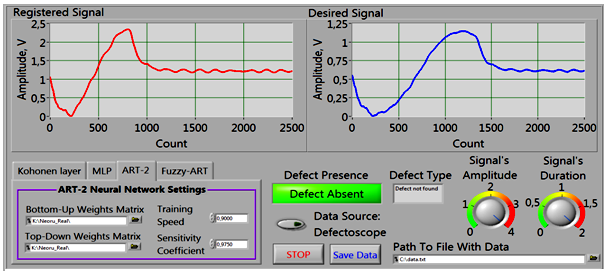 | Figure 4. User interface of developed system |
5. Neural Network Classifier
- Input data processing and signal classification isperformed with usage of artificial neural networks. They are used due to fact that in the problems of nondestructive testing the NN allows to determine (classify) retrieved informative signals with high reliability and perform correct classification of new signals which were not previously presented to neural network during training. The usage of neural networks guaranties the high noise immunity, increases the reliability of control and entire system performance and decreases the system software and hardware costs.The work of NN classifier which based on Kohonen NN (Kohonen layer) and multilayer perceptron could be described in such way. Firstly the multidimensional array which describe system input signal comes to classifier input from defectoscope, ADC or file stored on data storage. Next this array is processed by Kohonen layer (it forms classes and training samples for multilayer perceptron training). Formed by Kohonen layer classes and samples are used for setting up the weights of multilayer perceptron.Classification is performed by the multilayer perceptron. The special observing unit determines appearance of new or abnormal objects which do not belong to any of the existent in the NN memory classes. In the case of such appearance the new class is formed in the system memory which corresponds for appeared object and the NN classifier performs reconfiguration. As a result there is no necessary to form the huge set of predefined etalon defects for system initial configuring. However the system reconfiguring during new class appearance requires additional time resources.After retrieving from NN the information about defect class the system generates report about the result of nondestructive testing in the user-friendly format. It is stored on the data storage or displayed to operator.The Kohonen layer is used due to ability to perform cluster analysis and forming initial training samples for multilayer perceptron training. The result of Kohonen layer work is a set of possible classes (defects of object under control). Next this set could be used for initial multilayer perceptron training. In contrast to the classical realization of Kohonen NN or Kohonen maps in which due to different class sizes every class is described by several neurons, in the developed system the other approach is used. Every class has its own center and orbit which determines the variance of the objects in this class and specifies the size of class. Thus the information about class (center and size) is contained only in one neuron from Kohonen layer. The Kohonen layer training is performed by WTA (winner takes all) method[37]. Each neuron in Kohonen layer determines the distance from new input object to class center, to class orbit and the quotient of these two values. Such algorithm allows define object class exactly. The lack of this approach is in concentrated NN memory, i.e. information about one class is stored in one neuron and in case of its crash information about entire class will be lost. This lack could be resolved by using additional copying of NN parameters. However this copying needs less memory then approach with several neurons for one class but in cases of NN damage guaranties its reliability.For defect classifying of objects from composite materials the multilayer perceptron with three layers and multiple numbers of neurons in each layer was implemented. The number of neurons in output layer depends on the number of possible object under control classes. The number of neurons in hidden layers depends on the complexity of separating hyperplanes for features spaces separation.Every layer performs nonlinear transformation of the linear combination of input layer signal (output signal of previous layer) and its weights. Based on multilayer perceptron classifier allows solving the wide set of classification problems with different complexity and has high reliability of control and classification.For multilayer perceptron training backpropagation algorithm[37] was used. Training set for this purposes was created by Kohonen layer in the train of the cluster analysis of registered data. Program listing of module which performs Kohonen layer training is shown in Fig. 6a. There are two main blocks in this module:1) Distance finder block – evaluates value of the distance function. This value is used for calculating degree of similarity of the input vector and etalon vector in neural network’s memory. Distance finder block implements the following distance functions: Euclidean, squared Euclidean distance, Manhattan distance, Chebyshev distance, Mahalanobis distance, Jeffries-Matusita distance etc. In more details this part of software is described in[24].
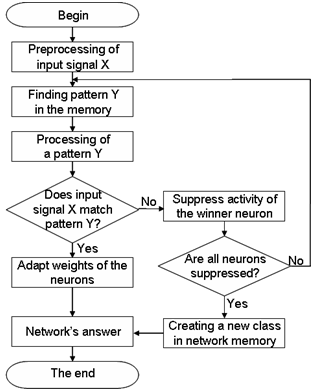 | Figure 5. The ART neural networks algorithm |
 | Figure 6. Program listings of modules which perform Kohonen layer training (a) and multilayer perceptron training (b) |
 | Figure 7. Program listing of module which implements multilayer perceptron |
6. Experimental Part
- For the developed software testing were used samples of honeycomb panels which were provided by the state enterprise "Antonov" and were used in the manufacture of aircraft models "An":Two samples (S1 and S2) of honeycomb panels from wings of aircraft type An-70 (Fig. 8a, 8b) of the material ELUR-P-0.1 and honeycomb filler PSP-1-2.5-45 with 10 mm of thickness with artificially formed defects. The following types of defects were under control: peeling skin on the inside of the filler cladding (Fig. 10a, 10b); control was made from the outside of the cladding;One sample (S3) of the composite panel of aluminum alloy sheet gluing and sealing "viksint" which is used on the aircraft An-140 (Fig. 8c) with artificial defects like as delamination of the sealant. Control was made from the outside of the cladding (Fig. 10c).
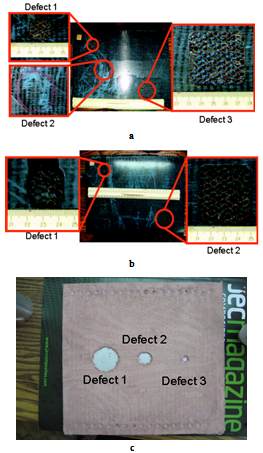 | Figure 8. Samples S1 (a), S2 (b) and S3(c) of honeycomb panels (bottom view) |
 | Figure 9. Program listing of modules which implements ART-2 (a) and Fuzzy-ART (b) neural networks |
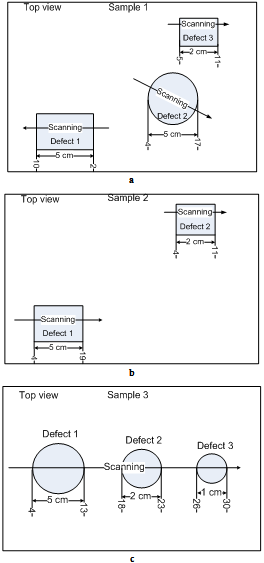 | Figure 10. Location of defects in samples S1 (a), S2 (b) and S3 (c). Scanning was made with step 2mm |
 | Figure 11. Informative signals which were obtained from areas without defects and areas with different defects during non-destructive testing of honeycomb panel samples S1(a), S2(b) and S3(c) |
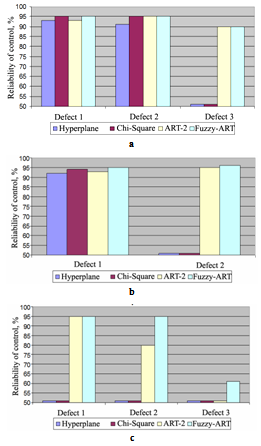 | Figure 12. Reliability of control of honeycomb panel samples S1(a), S2(b) and S3(c) |
7. Conclusions
- Special software of nondestructive testing system was developed by authors. This software allows obtain more information about the technical state of complex objects under control, perform classification of possible defects and detect appearance of anomalies in material structure.Developed software increases the reliability of the object’s technical state classification, reduces timetable and computational burden for data signal processing and decision making.For signal processing in developed software classifier based on hybrid neural network and neural network of adaptive resonance theory (ART-2 and Fuzzy-ART) is used. It allows provide non-linear separation and classification of objects by a set of diagnostic parameters, detect complex relationship between the damage degree of an object under control and informative parameters values. Described classifier during the training can automatically change its settings, reaching the highest reliability of the control, detect and classify subsurface defects in honeycomb panels with high reliability and accuracy, as well as defects that are located on the back side of the cladding with plottage larger than 2 cm2 and thickness of composite panel equal to 12.8 mm. The reliability of the nondestructive testing via specified classifier is more than 95%.Developed software advantages are in its architecture flexibility, high performance and reliability of data signal processing, human-engineered interface. At the moment developed software is in pilot testing and used at the department of information-measuring systems of the National Aviation University for the experimental data processing obtained during the nondestructive testing of composite materials.
 Abstract
Abstract Reference
Reference Full-Text PDF
Full-Text PDF Full-Text HTML
Full-Text HTML